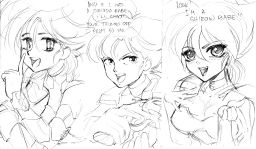Anime and manga
- "Oni anime" redirects here. For the game's opening and ending movies, see Intro and Outro. For their respective soundtracks, see Music/CD#Oni Anime and Music/CD#End Titles.
Apart from the intro and outro (and, arguably, the 1998 trailer), there has been no anime about Oni. You may want to check out Ghost in the Shell (more particularly "Stand Alone Complex") as Oni's most direct influence.
- There has been a Russian hoax called Oni 2: Next Generation. It's supposed to be a feature-length anime/CGI sequel to Oni, but is actually a Russian fandub of the Appleseed movie. Not a very recommendable fandub, too: obscenities all over the place, and little respect for the original. The excerpts that used to be featured on the hoax pages are now gone, but if you're interested in the whole dub it's apparently still available.
There is no official manga about Oni either. There is art by Lorraine, though, and the Dark Horse comic series. And fan art of course.
- See the Anime_and_Manga portal on Wikipedia for general information about manga and anime. The following introduction was adapted from that portal.
|
The characteristic visual style shared by anime and manga can be called "anime" or "manga" depending on the context. Apart from the general characteristic, there is a variety of styles highly characteristic of "schools" or individual artists. There are also categories based on the targeted audience, and general archetypes (e.g., Shina-tan up there is a generic example of the chibi aka super-deformed style).
The main influence for Oni was the manga/anime franchise Ghost in the Shell, and so the characteristic manga/anime style is very present in Oni (for a game that was made in the US). Alex Okita came up with some character/environment design, more or less anime- and GITS-inspired. The intro and outro sequences were made by an actual anime studio called AIC.
Later on, Lorraine Reyes McLees (a manga artist) joined the team, contributing 2D art (splashscreens, fly-in portraits, ...) and essentially setting a canon for Oni's graphical universe. The infamous Dark Horse comic series has little to do with manga, but Lorraine's work is influential/authoritative among many fan artists. Of course, original fan artists typically diverge from Lorraine's legacy.
On another note, Oni's 3D content in the form released by Bungie is not particularly close to anime/manga guidelines (character design); this is never an easy thing because of how anime is essentially 2D (the animation is made of custom tricks that typically don't correspond to a single 3-dimensional "truth"), but there may still be some improvement in that respect (see Anniversary Edition).
Echoes of Oni in anime and manga
- These references can be considered as added value for Oni's universe, and possible influences for an Oni 2 (whatever that is).
- Nausicaa (many aspects)
- Ergo Proxy (many aspects)
- Ghost in the Shell (duh)
- Appleseed
- GUNNM aka Battle Angel Alita
- Knives from Trigun (sorta Muro)
- Kill Bill (killing philosophy)
- Full Metal Panic! (Melissa Mao)
- ...
See also
There's more to culture than anime and manga. Here are some further lists of references.
